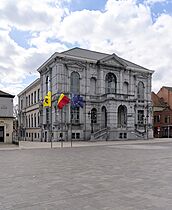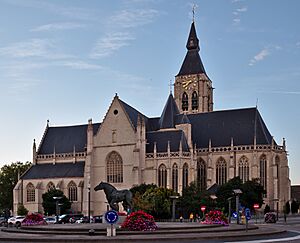Vilvoorde facts for kids
Quick facts for kids
Vilvoorde
Vilvorde (French)
|
|||
|---|---|---|---|

Town Hall
|
|||
|
|||
| Country | Belgium | ||
| Community | Flemish Community | ||
| Region | Flemish Region | ||
| Province | Flemish Brabant | ||
| Arrondissement | Halle Vilvoorde | ||
| Area | |||
| • Total | 21.48 km2 (8.29 sq mi) | ||
| Population
(2018-01-01)Lua error in Module:Wd at line 1575: attempt to index field 'wikibase' (a nil value).
|
|||
| • Total | Lua error in Module:Wd at line 1,575: attempt to index field 'wikibase' (a nil value). | ||
| Postal codes |
1800
|
||
| Area codes | 02 - 015 | ||
| Website | www.vilvoorde.be | ||
Vilvoorde is a city and municipality in Belgium. It is located in the Flemish Brabant province, which is part of the Flanders region. The city includes smaller areas like Koningslo, Houtem, and Peutie.
The main language spoken in Vilvoorde is Dutch. However, many people also speak French, especially in the Koningslo and Beauval areas. These parts are close to Brussels.
Vilvoorde has had some important mayors. From 2000 to 2007, the mayor was Jean-Luc Dehaene, who used to be the Prime Minister of Belgium. Since 2013, the mayor has been Hans Bonte. He is also a member of the Belgian Parliament.
Contents
Vilvoorde's Past: A Look Back
How Vilvoorde Began
People likely settled in the Vilvoorde area a very long time ago. The Nervii, an ancient tribe, and later the Romans, probably lived here. This spot was good because it was near the Zenne river.
The name Filfurdo was first written down in a document from the year 779. This name probably means "a village at the river crossing" or "ford." A ford is a shallow place where you can cross a river.
Growing Up in the Middle Ages
In the 1100s, Vilvoorde started to become a small town. It quickly became important to the dukes of Brabant. In 1192, Henry I, Duke of Brabant gave Vilvoorde special rights. This helped the town grow and get support from its people.
These rights allowed Vilvoorde to build defensive walls and sell its goods. This made the town's economy much stronger, especially its cloth industry. By the 1300s, Vilvoorde was a key military center because of its location on the Zenne river. It even competed with bigger cities like Leuven and Brussels.
From the 1400s to Today
From the 1400s to the 1800s, Vilvoorde faced tough times. It struggled because of competition from Brussels and problems in the textile industry. Diseases and wars also caused many difficulties for the city.
In 1536, William Tyndale, who translated the Bible into English, was executed here. Later, in 1597, Anna Utenhoven was buried alive in Vilvoorde for her religious beliefs. This was the last time someone was killed for their faith in the Habsburg Netherlands.
The Industrial Revolution in the late 1700s brought new life to Vilvoorde. The city was close to Brussels and had good ways to transport goods. Canals were made deeper around 1830, and railways arrived in 1835. Old buildings were replaced with new ones. The city hall we see today was built then.
In the 1920s, the canal was made even wider and deeper. New industrial areas were built, and a port was added for large cargo ships. After World War II, Vilvoorde became one of the biggest industrial areas near Brussels. Its population grew a lot.
However, recent economic problems have affected the city. For example, the Renault car factory closed in 1997. Now, the service industry, like shops and offices, is becoming more important in Vilvoorde.
Exploring Vilvoorde: What to See
- The city's main square has a beautiful city hall and a covered market.
- You can see a statue of a Brabant horse nearby. This statue reminds everyone of Vilvoorde's history with horse trading.
- The Kijk-Uit house is a very old building, dating back to the 1400s or 1500s.
- Vilvoorde has interesting churches. The Onze-Lieve-Vrouwekerk (Church of Our Lady) was started in the 1300s. The basilica of Onze-Lieve-Vrouw-ten-Troost (Our Lady of Consolation) was built in the 1600s in a fancy Baroque style.
- The city also has lovely parks. The Hanssenspark has English gardens. The Domein Drie Fonteinen (Domain of the Three Fountains) has both English and French gardens.
- The Vilvoorde Viaduct is a large bridge that is part of the Brussels ring road.
Fun Events in Vilvoorde
- Like many other Belgian cities, Vilvoorde has a week-long carnival. This fun event happens every year around Shrove Tuesday, which is usually in late February or early March.
- Every year, three weeks after Easter, there is a very popular market called a "jaarmarkt." This market has competitions and shows with farm animals like horses, cows, and chickens. At the same time, a week-long fair starts, with lots of rides and attractions for children.
Vilvoorde's Diverse Population
Vilvoorde is a very diverse city. As of 2015, about 43% of the people living there were born in other countries. Many residents are from outside Europe, especially from Arab and African countries.
The city also has a large community of Spanish residents. There is a big Moroccan community, along with smaller groups of people from Turkey, Macedonia, and Portugal.
Famous People from Vilvoorde
- Jancko Douwama (died 1533) was a nobleman who fought for freedom in Friesland. He was held prisoner in Vilvoorde castle.
- Jan van Essen and Hendrik Vos (died 1523) were among the first Lutherans executed by the Roman Catholic Church. They were imprisoned in Vilvoorde.
- Jean-François Portaels (1818–1895) was a famous painter known for his orientalist art.
- Jean-Luc Dehaene (1940–2014) was a former Belgian Prime Minister.
- Danny Devos (born 1959) is an artist known for his body art and performance art.
- Francis Heylighen (born 1960) is a scientist who studies complex systems.
- Pascal Duquenne (born 1970) is an actor.
- Yannick Carrasco (born 1993) is a well-known football player who grew up in Vilvoorde.
- Jan Baptist van Helmont (1580–1644) was a pioneer in the field of chemistry.
- Paul Panda Farnana (1888 – 1930) was a Congolese intellectual and activist.
- Amelie Lens (born 1990) is a popular DJ and music producer.
- Veronique Branquinho (born 1973) is a fashion designer.
- Jan Vercauteren (born 1999) is a DJ and producer.
- Magda Goebbels (1901 - 1945) attended the Ursuline Convent in Vilvoorde as a child.
Vilvoorde's Sister Cities
Vilvoorde has special connections with several cities around the world. These are called "twin cities" or "sister cities." They often share cultural events and ideas.
 Germany: Ennepetal, Germany
Germany: Ennepetal, Germany France: Maubeuge, France
France: Maubeuge, France Netherlands: Middelburg, Netherlands
Netherlands: Middelburg, Netherlands Spain: Peñarroya-Pueblonuevo, Spain
Spain: Peñarroya-Pueblonuevo, Spain Japan: Komatsu, Ishikawa, Japan
Japan: Komatsu, Ishikawa, Japan
Images for kids
See also
 In Spanish: Vilvoorde para niños
In Spanish: Vilvoorde para niños






